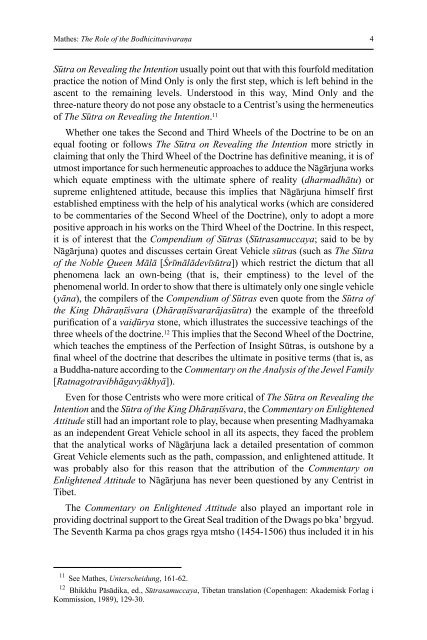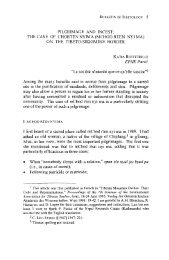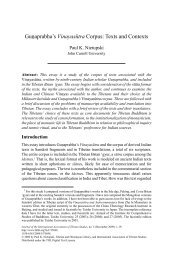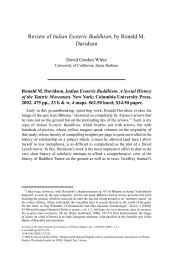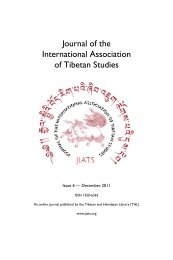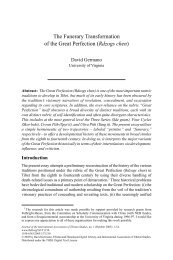The Role of the Bodhicittavivaraṇa in the Mahāmudrā Tradition of ...
The Role of the Bodhicittavivaraṇa in the Mahāmudrā Tradition of ...
The Role of the Bodhicittavivaraṇa in the Mahāmudrā Tradition of ...
Create successful ePaper yourself
Turn your PDF publications into a flip-book with our unique Google optimized e-Paper software.
Ma<strong>the</strong>s: <strong>The</strong> <strong>Role</strong> <strong>of</strong> <strong>the</strong> <strong>Bodhicittavivaraṇa</strong><br />
Sūtra on Reveal<strong>in</strong>g <strong>the</strong> Intention usually po<strong>in</strong>t out that with this fourfold meditation<br />
practice <strong>the</strong> notion <strong>of</strong> M<strong>in</strong>d Only is only <strong>the</strong> first step, which is left beh<strong>in</strong>d <strong>in</strong> <strong>the</strong><br />
ascent to <strong>the</strong> rema<strong>in</strong><strong>in</strong>g levels. Understood <strong>in</strong> this way, M<strong>in</strong>d Only and <strong>the</strong><br />
three-nature <strong>the</strong>ory do not pose any obstacle to a Centrist’s us<strong>in</strong>g <strong>the</strong> hermeneutics<br />
<strong>of</strong> <strong>The</strong> Sūtra on Reveal<strong>in</strong>g <strong>the</strong> Intention. 11<br />
Whe<strong>the</strong>r one takes <strong>the</strong> Second and Third Wheels <strong>of</strong> <strong>the</strong> Doctr<strong>in</strong>e to be on an<br />
equal foot<strong>in</strong>g or follows <strong>The</strong> Sūtra on Reveal<strong>in</strong>g <strong>the</strong> Intention more strictly <strong>in</strong><br />
claim<strong>in</strong>g that only <strong>the</strong> Third Wheel <strong>of</strong> <strong>the</strong> Doctr<strong>in</strong>e has def<strong>in</strong>itive mean<strong>in</strong>g, it is <strong>of</strong><br />
utmost importance for such hermeneutic approaches to adduce <strong>the</strong> Nāgārjuna works<br />
which equate empt<strong>in</strong>ess with <strong>the</strong> ultimate sphere <strong>of</strong> reality (dharmadhātu) or<br />
supreme enlightened attitude, because this implies that Nāgārjuna himself first<br />
established empt<strong>in</strong>ess with <strong>the</strong> help <strong>of</strong> his analytical works (which are considered<br />
to be commentaries <strong>of</strong> <strong>the</strong> Second Wheel <strong>of</strong> <strong>the</strong> Doctr<strong>in</strong>e), only to adopt a more<br />
positive approach <strong>in</strong> his works on <strong>the</strong> Third Wheel <strong>of</strong> <strong>the</strong> Doctr<strong>in</strong>e. In this respect,<br />
it is <strong>of</strong> <strong>in</strong>terest that <strong>the</strong> Compendium <strong>of</strong> Sūtras (Sūtrasamuccaya; said to be by<br />
Nāgārjuna) quotes and discusses certa<strong>in</strong> Great Vehicle sūtras (such as <strong>The</strong> Sūtra<br />
<strong>of</strong> <strong>the</strong> Noble Queen Mālā [Śrīmālādevīsūtra]) which restrict <strong>the</strong> dictum that all<br />
phenomena lack an own-be<strong>in</strong>g (that is, <strong>the</strong>ir empt<strong>in</strong>ess) to <strong>the</strong> level <strong>of</strong> <strong>the</strong><br />
phenomenal world. In order to show that <strong>the</strong>re is ultimately only one s<strong>in</strong>gle vehicle<br />
(yāna), <strong>the</strong> compilers <strong>of</strong> <strong>the</strong> Compendium <strong>of</strong> Sūtras even quote from <strong>the</strong> Sūtra <strong>of</strong><br />
<strong>the</strong> K<strong>in</strong>g Dhāraṇīśvara (Dhāraṇīśvararājasūtra) <strong>the</strong> example <strong>of</strong> <strong>the</strong> threefold<br />
purification <strong>of</strong> a vaiḍūrya stone, which illustrates <strong>the</strong> successive teach<strong>in</strong>gs <strong>of</strong> <strong>the</strong><br />
three wheels <strong>of</strong> <strong>the</strong> doctr<strong>in</strong>e. 12 This implies that <strong>the</strong> Second Wheel <strong>of</strong> <strong>the</strong> Doctr<strong>in</strong>e,<br />
which teaches <strong>the</strong> empt<strong>in</strong>ess <strong>of</strong> <strong>the</strong> Perfection <strong>of</strong> Insight Sūtras, is outshone by a<br />
f<strong>in</strong>al wheel <strong>of</strong> <strong>the</strong> doctr<strong>in</strong>e that describes <strong>the</strong> ultimate <strong>in</strong> positive terms (that is, as<br />
a Buddha-nature accord<strong>in</strong>g to <strong>the</strong> Commentary on <strong>the</strong> Analysis <strong>of</strong> <strong>the</strong> Jewel Family<br />
[Ratnagotravibhāgavyākhyā]).<br />
Even for those Centrists who were more critical <strong>of</strong> <strong>The</strong> Sūtra on Reveal<strong>in</strong>g <strong>the</strong><br />
Intention and <strong>the</strong> Sūtra <strong>of</strong> <strong>the</strong> K<strong>in</strong>g Dhāraṇīśvara, <strong>the</strong> Commentary on Enlightened<br />
Attitude still had an important role to play, because when present<strong>in</strong>g Madhyamaka<br />
as an <strong>in</strong>dependent Great Vehicle school <strong>in</strong> all its aspects, <strong>the</strong>y faced <strong>the</strong> problem<br />
that <strong>the</strong> analytical works <strong>of</strong> Nāgārjuna lack a detailed presentation <strong>of</strong> common<br />
Great Vehicle elements such as <strong>the</strong> path, compassion, and enlightened attitude. It<br />
was probably also for this reason that <strong>the</strong> attribution <strong>of</strong> <strong>the</strong> Commentary on<br />
Enlightened Attitude to Nāgārjuna has never been questioned by any Centrist <strong>in</strong><br />
Tibet.<br />
<strong>The</strong> Commentary on Enlightened Attitude also played an important role <strong>in</strong><br />
provid<strong>in</strong>g doctr<strong>in</strong>al support to <strong>the</strong> Great Seal tradition <strong>of</strong> <strong>the</strong> Dwags po bka’ brgyud.<br />
<strong>The</strong> Seventh Karma pa chos grags rgya mtsho (1454-1506) thus <strong>in</strong>cluded it <strong>in</strong> his<br />
11 See Ma<strong>the</strong>s, Unterscheidung, 161-62.<br />
12 Bhikkhu Pāsādika, ed., Sūtrasamuccaya, Tibetan translation (Copenhagen: Akademisk Forlag i<br />
Kommission, 1989), 129-30.<br />
4


